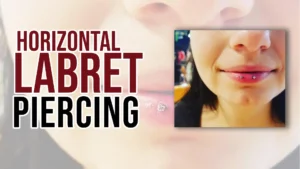People commonly begin preparing for the beach and pool as better weather appears in the spring. Every year, many people are determined to liven up their appearance by getting their belly buttons pierced.
There is aftercare necessary for every piercing in order to promote recovery. It’s simple for something like your shirt, or jeans or even a child to accidentally discover your piercings and take them out. However, accidents sometimes occur, and a belly button piercing being torn out is a typical problem because of its place on the body.
How Much Time Does It Take a Ripped Belly Piercing To Heal?
The healing process will differ from person to person because your piercing could be ripped out for a variety of causes. For example, the piercing will definitely completely fall out if you run into something or pull it with your shirt. However, you will bleed a bit and feel a lot of pain in this case.
Rejection may also cause your piercing to fall out. Recognizing that your body could reject jewelry and start to perceive it as an alien object is a simple approach to comprehending the rejection process. The time of this process can range from a few days to a few weeks. In this case, as the tissue heals, the puncture will gradually move. The piercing will therefore come out.
How fast you can rip out a Belly Button Ring?
However, removing the piercing is possible once your skin has recovered. The chance that your belly button piercing will come away depends on a number of factors. They include the ring’s material, piercing technique, rejection, and infection.
1. Rejection
It’s likely that the jewelry will completely or partially move after you have your belly piercings. When migration begins, also known as metal migration, it means that your body is rejecting the metal. Usually, this takes place while your body tries to repair itself.
Our body may push the jewelry out occasionally if the migration continues. After some time, the rejection may cause your belly button to rip off. Therefore, the choice of inexpensive materials, the length of the dumbbell, or unprofessional piercing techniques are major causes of rip-offs resulting from rejection.
2. Bacterial Infection
Bacterial infection can also cause rip-outs because it affects the tissues around the piercing. After being pierced, you could get an infectious disease. But if you don’t take care of yourself afterward, the bacteria might also enter your body and infect you.
3. Changing Your Clothes
The most common cause of piercing removal is changing clothes. You jerk on it before you realize it and feel pain in it now. However, your finger, your clothes, or even something little like a bracelet could get caught in the piercing very easily.
4. Incorrect Piercing
The piercing might also rip off if the procedure was carried out incorrectly. It’s common to make problems like not piercing deep enough or using enough material.
Can You Re-pierce Your Belly Button If It Was Ripped Out?
It is important to follow aftercare procedures after having a piercing. While going through the healing process, have the following in mind:
Step 1: Avoid Traveling to the Beaches
You should stay out of the water, such as hot tubs, lakes, pools, and the beach, until you’re piercing has fully healed. In particular, if you are on a sandy beach, particles could enter the body through the entrance.
Staying in the water can promote bacteria to enter the new scar since your body is presently healing.
Step 2: Choose the Right Size of Jewelry
In all piercing types, rejection and migration are extremely common. Your body may reject the piercing for a variety of reasons, but picking the wrong material for the ring might have a big impact. However, naval piercing is where it happens more commonly.
Step 3: Take Salt or Saline Soak Bath
You can pour a cup with sea salt or aftercare saline solution. To soak the scar for five minutes, press down on the cup to produce suction.
After that, you can dry the area and carefully relocate the cup. On the other hand, you should make sure the cup is big enough so you can put it on your belly. Now crouch down and dip the piercing into the cup.
Step 4: Be Careful About Clothing
Not all belly button piercings end up being removed due to rejection or infection. Problems may also be caused by your clothing. However, when changing clothes, try to keep your piercing in mind at all times.
Final Verdict:
One of the main concerns of getting a belly button piercing, like any piercing, is having it taken out. If you care deeply about your navel piercing, you will take all necessary precautions to prevent infection as well as other skin problems. Although it could cause pain, taking care of your piercing is important.
FAQs:
How do you handle a piercing that comes out?
Unfortunately, it is impossible to repair an earring hole ripped out or damaged without surgery. You have to get expert suggestions to recover it.
Can your belly button be pierced again in the same location?
The extensive scar tissue (fibrosis) that has developed since your piercing was removed. Additionally, the only areas that have often healed are the entry and exit locations. Therefore, getting re-pierced in the same place can be an excellent place to establish a piercing.
How could a belly button piercing be repaired?
The idea behind trying to repair a torn earlobe is the same. If you do not have a gaping hole but have a giant scar instead, such as our elevator friend’s belly button, a dermatologist can provide cortisone injections to reduce the size of the scar.





